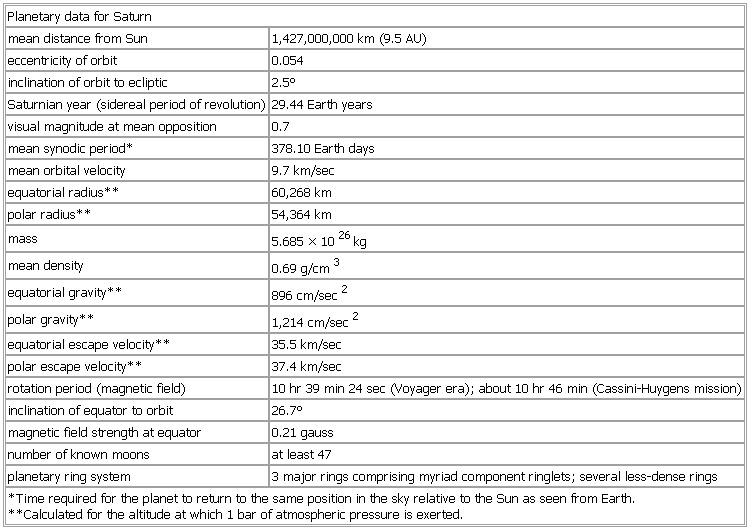Planetary data for Saturn
- Planetary data for Saturn
-
Planetary data for Saturn
mean distance from Sun 1,427,000,000 km (9.5 AU)
eccentricity of orbit 0.054
inclination of orbit to ecliptic 2.5°
Saturnian year (sidereal period of revolution) 29.44 Earth years
visual magnitude at mean opposition 0.7
mean synodic period* 378.10 Earth days
mean orbital velocity 9.7 km/sec
equatorial radius** 60,268 km
polar radius** 54,364 km
mass 5.685 × 1026 kg
mean density 0.69 g/cm3
equatorial gravity** 896 cm/sec2
polar gravity** 1,214 cm/sec2
equatorial escape velocity** 35.5 km/sec
polar escape velocity** 37.4 km/sec
rotation period (
magnetic field)
10 hr 39 min 24 sec (
Voyager era);
about 10 hr 46 min (
Cassini-
Huygens mission)
inclination of equator to orbit 26.7°
magnetic field strength at equator 0.21 gauss
number of known moons at least 47
planetary ring system 3 major rings comprising myriad component ringlets; several less-dense rings
*Time required for the planet to return to the same position in the sky relative to the Sun as seen from Earth.
**Calculated for the altitude at which 1 bar of atmospheric pressure is exerted.
See as table:
* * *
Universalium.
2010.
Look at other dictionaries:
Saturn — /sat euhrn/, n. 1. an ancient Roman god of agriculture, the consort of Ops, believed to have ruled the earth during an age of happiness and virtue, identified with the Greek god Cronus. 2. Astron. the planet sixth in order from the sun, having an … Universalium
Planetary habitability — is the measure of a planet s or a natural satellite s potential to develop and sustain life. As the existence of life beyond Earth is currently uncertain, planetary habitability is largely an extrapolation of conditions on Earth and the… … Wikipedia
Saturn Nebula — NGC 7009 by Hubble Space Telescope Observation data (Epoch J2000.0) Right ascension 21h� … Wikipedia
Planetary science — Planetary science, also known as planetology and closely related to planetary astronomy, is the science of planets, or planetary systems, and the solar system. Incorporating an interdisciplinary approach, planetary science draws from diverse… … Wikipedia
Planetary nomenclature — Planetary nomenclature, like terrestrial nomenclature, is a system of uniquely identifying features on the surface of a planet or natural satellite so that the features can be easily located, described, and discussed. The task of assigning… … Wikipedia
Saturn — Infobox Planet bgcolour = #FFCC66 name = Saturn symbol = caption = Saturn, as seen by Cassini orbit ref =cite web last = Yeomans | first = Donald K. | date = 2006 07 13 url = http://ssd.jpl.nasa.gov/?horizons title = HORIZONS System | publisher … Wikipedia
Planetary mass — The four terrestrial planets in the Solar System, to scale. Note that Mars (to the far right) is about half the diameter of the Earth, but only one ninth of the mass … Wikipedia
Saturn V — Infobox rocket caption = The first Saturn V, AS 501, before the launch of Apollo 4 name = Saturn V function = Manned LEO and Lunar launch vehicle manufacturer = Boeing (S IC) North American (S II) Douglas (S IVB) country origin = United States… … Wikipedia
Rings of Saturn — The full set of main rings, imaged as Saturn eclipsed the Sun from the vantage of the Cassini spacecraft on 15 September 2006 (brightness is exaggerated). The pale blue dot at the 10 o clock position, outside the main rings and just inside the G… … Wikipedia
Moons of Saturn — Artist s concepts of the Saturnian ring–moon system Saturn, its rings and major icy moons from Mimas to Rhea … Wikipedia

